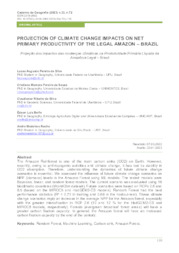Projection of climate change impacts on net primary productivity of the legal Amazon - Brazil.
Projection of climate change impacts on net primary productivity of the legal Amazon - Brazil.
Author(s): SILVA, L. A. P. da; SOUZA, C. M. P. de; SILVA, C. R. da; BOLFE, E. L.; ROCHA, A. M.
Summary: Abstract. The Amazon Rainforest is one of the main carbon sinks (CO2) on Earth. However, recently, owing to anthropogenic activities and climate change, it has lost its stability in CO2 absorption. Therefore, understanding the dynamics of future climate change scenarios is essential. We assessed the influence of future climate change scenarios on NPP (biomass) levels in the Amazon Forest using ML models. The tested models were Bayesian, linear, and random forest models. The current scenario was evaluated using 19 bioclimatic covariates (WorldClim dataset). Future scenarios were based on RCPs 2.6 and 8.5 (based on the MIROC5 and HadGEM2-ES models). Random Forest had the best performance statistics (R² = 0.71 in training and 0.68 in the holdout-test). These climate change scenarios imply an increase in the average NPP for the Amazon forest, especially with the greater intensification in RCP 2.6 (10 and 12 % for the HadGEM2-ES and MIROC5 models, respectively). Forests (evergreen broadleaf forest areas) will have a greater carbon fixation capacity. In general, the Amazon forest will have an increased carbon fixation capacity by the end of the century.
Publication year: 2023
Types of publication: Journal article
Observation
Some of Embrapa's publications are published as ePub files. To read them, use or download one of the following free software options to your computer or mobile device. Android: Google Play Books; IOS: iBooks; Windows and Linux: Calibre.
Access other publications
Access the Agricultural Research Database (BDPA) to consult Embrapa's full library collection and records.
Visit Embrapa Bookstore to purchase books and other publications sold by Embrapa.

